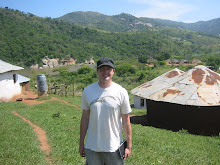"Zulu Lessons in Cultural Design & Planning"
KwaZulu-Natal, South Africa
The planning and design of cultural-based tourism is big business. Communities around the world are recognizing the draw cultural destinations have for a tourist population who is increasingly interested in migrating away from the well-polished, scripted tour experience. Architects, planners and related professionals are being called to duty; asked to work with local communities in establishing cultural-based destinations all around the globe.
KwaZulu-Natal in South Africa is one region where an increasing number of indigenous tribes are turning to cultural tourism as a means in which to bring opportunity to their community. And with the upcoming World Cup coming to town later this year, efforts to establish and market cultural sites are at an all-time high.
In 2006, I visited dozens of recreated Zulu and Swazi “villages” as well as stayed in a local Zulu village (Mapapatepe) – all in the effort to understand what may be lost or gained from each experience, and hopefully, in the process, use what I learned to better design and plan future cultural-based sites.*
No surprise, spending several days in a community, eating, sleeping, even doing local chores, provides an outsider with a perspective that can never be quite captured in an hour tour or with a colorful brochure. And conversely, there were times that I yearned for a tour guide or brochure to help me navigate through various language and cultural barriers that often sprang up while staying in the Zulu village.

So, in the case of the homestay experience, what can be learned and potentially applied to the design of cultural-based tourist destinations? Distilled from this experience are some of my questions and thoughts in regard to the design and planning of cultural-based attractions.
- Can planning and design efforts positively impact individual communities (improve infrastructure, provide valuable resources, create business) in the process of creating an attraction for tourists?
- Recognize that culture is not static and doesn't need to be framed entirely in the context of the past. Embrace the contemporary aspects of one's culture, telling the story of how the present intertwines with the past.
- Deepen understanding of culture through the exploration of personal engagement and interaction between tourist and local community. How can design and planning efforts better facilitate this exchange?
No doubt more research is needed. It is my hope that with additional insight we as designers will be better equipped to assist local communities in effectively communicating and sharing respective cultural elements while providing opportunity for economic development.

*In 2006, I received the Scott Travelling Fellowship through UC Berkeley's College of Environmental Design. This research trip was one of many in my Fellowship travels; exploring the expression and transmission of culture in various indigenous tourist destinations.
 The space needed to be flexible; accommodating the everyday uses associated with a front yard while also being able to transform into the occasional space for parties and informal get-togethers.
The space needed to be flexible; accommodating the everyday uses associated with a front yard while also being able to transform into the occasional space for parties and informal get-togethers.












